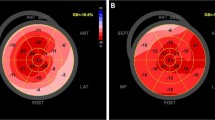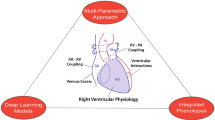Abstract
The efficacy of convolutional neural network (CNN)-enhanced electrocardiography (ECG) in detecting hypertrophic cardiomyopathy (HCM) and dilated HCM (dHCM) remains uncertain in real-world applications. This retrospective study analyzed data from 19,170 patients (including 140 HCM or dHCM) in the Shinken Database (2010–2017). We evaluated the sensitivity, positive predictive rate (PPR), and F1 score of CNN-enhanced ECG in a ‘‘basic diagnosis’’ model (total disease label) and a ‘‘comprehensive diagnosis’’ model (including disease subtypes). Using all-lead ECG in the "basic diagnosis" model, we observed a sensitivity of 76%, PPR of 2.9%, and F1 score of 0.056. These metrics improved in cases with a diagnostic probability of ≥ 0.9 and left ventricular hypertrophy (LVH) on ECG: 100% sensitivity, 8.6% PPR, and 0.158 F1 score. The ‘‘comprehensive diagnosis’’ model further enhanced these figures to 100%, 13.0%, and 0.230, respectively. Performance was broadly consistent across CNN models using different lead configurations, particularly when including leads viewing the lateral walls. While the precision of CNN models in detecting HCM or dHCM in real-world settings is initially low, it improves by targeting specific patient groups and integrating disease subtype models. The use of ECGs with fewer leads, especially those involving the lateral walls, appears comparably effective.







Similar content being viewed by others
Data availability
Data cannot be shared publicly because of a lack of such a description in the study protocol and informed consent. Data are available from the Ethics Review Committee at the Cardiovascular Institute for researchers who meet the criteria for access to confidential data (contact via the corresponding author).
References
Maron BJ, Haas TS, Murphy CJ, Ahluwalia A, Rutten-Ramos S (2014) Incidence and causes of sudden death in US college athletes. J Am Coll Cardiol 63(16):1636–1643
Maron BJ (2010) Risk stratification and role of implantable defibrillators for prevention of sudden death in patients with hypertrophic cardiomyopathy. Circ J 74(11):2271–2282
Maron BJ (2002) Hypertrophic cardiomyopathy: a systematic review. JAMA 287(10):1308–1320
Maron BJ (2018) Clinical course and management of hypertrophic cardiomyopathy. N Engl J Med 379(7):655–668
Maron BJ, Rowin EJ, Casey SA, Maron MS (2016) How Hypertrophic cardiomyopathy became a contemporary treatable genetic disease with low mortality: shaped by 50 years of clinical research and practice. JAMA Cardiol 1(1):98–105
Ommen SR, Mital S, Burke MA, Day SM, Deswal A, Elliott P, Evanovich LL, Hung J, Joglar JA, Kantor P, Kimmelstiel C, Kittleson M, Link MS, Maron MS, Martinez MW, Miyake CY, Schaff HV, Semsarian C, Sorajja P (2020) 2020 AHA/ACC guideline for the diagnosis and treatment of patients with hypertrophic cardiomyopathy: a report of the American college of cardiology/American heart association joint committee on clinical practice guidelines. Circulation 142(25):e558–e631
McLeod CJ, Ackerman MJ, Nishimura RA, Tajik AJ, Gersh BJ, Ommen SR (2009) Outcome of patients with hypertrophic cardiomyopathy and a normal electrocardiogram. J Am Coll Cardiol 54(3):229–233
Frank S, Braunwald E (1968) Idiopathic hypertrophic subaortic stenosis clinical analysis of 126 patients with emphasis on the natural history. Circulation 37(5):759–788
Hughes RK, Knott KD, Malcolmson J, Augusto JB, Mohiddin SA, Kellman P, Moon JC, Captur G (2020) Apical hypertrophic cardiomyopathy: the variant less known. J Am Heart Assoc 9(5):e015294
Sheikh N, Papadakis M, Ghani S, Zaidi A, Gati S, Adami PE, Carre F, Schnell F, Wilson M, Avila P, McKenna W, Sharma S (2014) Comparison of electrocardiographic criteria for the detection of cardiac abnormalities in elite black and white athletes. Circulation 129(16):1637–1649
Maron BJ, Friedman RA, Kligfield P, Levine BD, Viskin S, Chaitman BR, Okin PM, Saul JP, Salberg L, Van Hare GF, Soliman EZ, Chen J, Matherne GP, Bolling SF, Mitten MJ, Caplan A, Balady GJ (2014) Assessment of the 12-lead electrocardiogram as a screening test for detection of cardiovascular disease in healthy general populations of young people (12–25 years of age): a scientific statement from the American heart association and the American college of cardiology. J Am Coll Cardiol 64(14):1479–1514
Pelliccia A, Maron BJ, Culasso F, Di Paolo FM, Spataro A, Biffi A, Caselli G, Piovano P (2000) Clinical significance of abnormal electrocardiographic patterns in trained athletes. Circulation 102(3):278–284
Ko WY, Siontis KC, Attia ZI, Carter RE, Kapa S, Ommen SR, Demuth SJ, Ackerman MJ, Gersh BJ, Arruda-Olson AM, Geske JB, Asirvatham SJ, Lopez-Jimenez F, Nishimura RA, Friedman PA, Noseworthy PA (2020) Detection of hypertrophic cardiomyopathy using a convolutional neural network-enabled electrocardiogram. J Am Coll Cardiol 75(7):722–733
Tison GH, Zhang J, Delling FN, Deo RC (2019) Automated and Interpretable patient ECG profiles for disease detection, tracking, and discovery. Circ Cardiovasc Qual Outcomes 12(9):e005289
Maanja M, Noseworthy PA, Geske JB, Ackerman MJ, Arruda-Olson AM, Ommen SR, Attia ZI, Friedman PA, Siontis KC (2022) Tandem deep learning and logistic regression models to optimize hypertrophic cardiomyopathy detection in routine clinical practice. Cardiovasc Digit Health J 3(6):289–296
Hirota N, Suzuki S, Motogi J, Nakai H, Matsuzawa W, Takayanagi T, Umemoto T, Hyodo A, Satoh K, Arita T, Yagi N, Otsuka T, Yamashita T (2023) Cardiovascular events and artificial intelligence-predicted age using 12-lead electrocardiograms. Int J Cardiol Heart Vasc 44:101172
Suzuki S, Motogi J, Nakai H, Matsuzawa W, Takayanagi T, Umemoto T, Hirota N, Hyodo A, Satoh K, Otsuka T, Arita T, Yagi N, Yamashita T (2022) Identifying patients with atrial fibrillation during sinus rhythm on ECG: significance of the labeling in the artificial intelligence algorithm. Int J Cardiol Heart Vasc 38:100954
Suzuki S, Otsuka T, Sagara K, Semba H, Kano H, Matsuno S, Takai H, Kato Y, Uejima T, Oikawa Y, Nagashima K, Kirigaya H, Kunihara T, Yajima J, Sawada H, Aizawa T, Yamashita T (2016) Nine-year trend of anticoagulation use, thromboembolic events, and major bleeding in patients with non-valvular atrial fibrillation- shinken database analysis. Circ J 80(3):639–649
Baecker L, Garcia-Dias R, Vieira S, Scarpazza C, Mechelli A (2021) Machine learning for brain age prediction: Introduction to methods and clinical applications. EBioMedicine 72:103600
Attia ZI, Noseworthy PA, Lopez-Jimenez F, Asirvatham SJ, Deshmukh AJ, Gersh BJ, Carter RE, Yao X, Rabinstein AA, Erickson BJ, Kapa S, Friedman PA (2019) An artificial intelligence-enabled ECG algorithm for the identification of patients with atrial fibrillation during sinus rhythm: a retrospective analysis of outcome prediction. The Lancet 394(10201):861–867
Hirota N, Suzuki S, Motogi J, Umemoto T, Nakai H, Matsuzawa W, Takayanagi T, Hyodo A, Satoh K, Arita T, Yagi N, Kishi M, Semba H, Kano H, Matsuno S, Kato Y, Otsuka T, Uejima T, Oikawa Y, Hori T, Matsuhama M, Iida M, Yajima J, Yamashita T (2023) Identification of patients with dilated phase of hypertrophic cardiomyopathy using a convolutional neural network applied to multiple, dual, and single lead electrocardiograms. Int J Cardiol Heart Vasc 46:101211
Coffin M, Sukhatme S (1997) Receiver operating characteristic studies and measurement errors. Biometrics 53(3):823–837
Selvaraju RR, Cogswell M, Das A, Vedantam R, Parikh D, Batra D (2017) Grad-CAM: Visual explanations from deep networks via gradient-based localization. IEEE International Conference on Computer Vision: 618–626, Accessd 6 Dec 2023. https://openaccess.thecvf.com/content_ICCV_2017/papers/Selvaraju_Grad-CAM_Visual_Explanations_ICCV_2017_paper.pdf
Hancock EW, Deal BJ, Mirvis DM, Okin P, Kligfield P, Gettes LS, Bailey JJ, Childers R, Gorgels A, Josephson M, Kors JA, Macfarlane P, Mason JW, Pahlm O, Rautaharju PM, Surawicz B, van Herpen G, Wagner GS, Wellens H, American Heart Association E, CoCC AC (2009) AHA/ACCF/HRS recommendations for the standardization and interpretation of the electrocardiogram: part V: electrocardiogram changes associated with cardiac chamber hypertrophy: a scientific statement from the american heart association electrocardiography and arrhythmias committee, council on clinical cardiology; the American college of cardiology foundation; and the heart rhythm society: endorsed by the international society for computerized electrocardiology. Circulation 119(10):e251-261
Siontis KC, Liu K, Bos JM, Attia ZI, Cohen-Shelly M, Arruda-Olson AM, Zanjirani Farahani N, Friedman PA, Noseworthy PA, Ackerman MJ (2021) Detection of hypertrophic cardiomyopathy by an artificial intelligence electrocardiogram in children and adolescents. Int J Cardiol 340:42–47
Attia ZI, Harmon DM, Behr ER, Friedman PA (2021) Application of artificial intelligence to the electrocardiogram. Eur Heart J 42(46):4717–4730
Bumgarner JM, Lambert CT, Hussein AA, Cantillon DJ, Baranowski B, Wolski K, Lindsay BD, Wazni OM, Tarakji KG (2018) Smartwatch algorithm for automated detection of atrial fibrillation. J Am Coll Cardiol 71(21):2381–2388
Chen W, Khurshid S, Singer DE, Atlas SJ, Ashburner JM, Ellinor PT, McManus DD, Lubitz SA, Chhatwal J (2022) Cost-effectiveness of screening for atrial fibrillation using wearable devices. JAMA Health Forum 3(8):e222419
Pepplinkhuizen S, Hoeksema WF, van der Stuijt W, van Steijn NJ, Winter MM, Wilde AAM, Smeding L, Knops RE (2022) Accuracy and clinical relevance of the single-lead apple watch electrocardiogram to identify atrial fibrillation. Cardiovasc Digit Health J 3(6 Suppl):S17–S22
Wasserlauf J, You C, Patel R, Valys A, Albert D, Passman R (2019) Smartwatch performance for the detection and quantification of atrial fibrillation. Circ Arrhythm Electrophysiol 12(6):e006834
Siontis KC, Suarez AB, Sehrawat O, Ackerman MJ, Attia ZI, Friedman PA, Noseworthy PA, Maanja M (2023) Saliency maps provide insights into artificial intelligence-based electrocardiography models for detecting hypertrophic cardiomyopathy. J Electrocardiol 81:286–291
Acknowledgements
We thank Shiro Ueda and Nobuko Ueda at Medical Edge Company, Ltd., for assembling the database by the Clinical Study Supporting System, and Yurika Hashiguchi, Hiroaki Arai, and Takashi Osada for data management and system administration.
Funding
This research did not receive any specific grant from funding agencies in the public, commercial, or not-for-profit sectors.
Author information
Authors and Affiliations
Contributions
NH: Conceptualization, Validation, Writing—original draft. SS: Conceptualization, Validation, Writing—review and editing. JM: Conceptualization, Validation. TU: Data curation, Formal analysis, Writing—original draft, Writing—review and editing. HN: Conceptualization, Data curation, Validation. WM: Data curation, Formal analysis. TT: Data curation, Formal analysis. AH: Formal analysis, Validation. KS: Formal analysis, Validation. TA: Writing—review and editing. NY: Writing—review and editing. MK: Writing—review and editing. HS: Writing—review and editing. HK: Writing—review and editing. SM: Writing—review and editing. YK: Writing—review and editing. TO: Writing—review and editing. YO: Writing—review and editing. TH: Writing—review and editing. MM: Writing—review and editing. MI: Writing—review and editing. JY: Writing—review and editing. TY: Writing—review and editing. All authors take responsibility for all aspects of the reliability and freedom from bias of the data presented and their discussed interpretation.
Corresponding author
Ethics declarations
Conflict of interests
Dr. Suzuki received lecture fees from Daiichi Sankyo and Bristol-Myers Squibb. Dr. Yamashita received research funds and/or lecture fees from Daiichi Sankyo, Bayer Yakuhin, Bristol-Myers Squibb, Pfizer, Nippon Boehringer Ingelheim, Eisai, Mitsubishi Tanabe Pharm, Ono Pharmaceutical, and Toa Eiyo. J Motogi, T Umemoto, W Matsuzawa, T Takayanagi, A Hyodo, and K Satoh are employees at Nihon Kohden Corporation.
Consent for publication
Not applicable.
Additional information
Publisher's Note
Springer Nature remains neutral with regard to jurisdictional claims in published maps and institutional affiliations.
Supplementary Information
Below is the link to the electronic supplementary material.
Rights and permissions
Springer Nature or its licensor (e.g. a society or other partner) holds exclusive rights to this article under a publishing agreement with the author(s) or other rightsholder(s); author self-archiving of the accepted manuscript version of this article is solely governed by the terms of such publishing agreement and applicable law.
About this article
Cite this article
Hirota, N., Suzuki, S., Motogi, J. et al. Evaluating convolutional neural network-enhanced electrocardiography for hypertrophic cardiomyopathy detection in a specialized cardiovascular setting. Heart Vessels (2024). https://doi.org/10.1007/s00380-024-02367-9
Received:
Accepted:
Published:
DOI: https://doi.org/10.1007/s00380-024-02367-9




